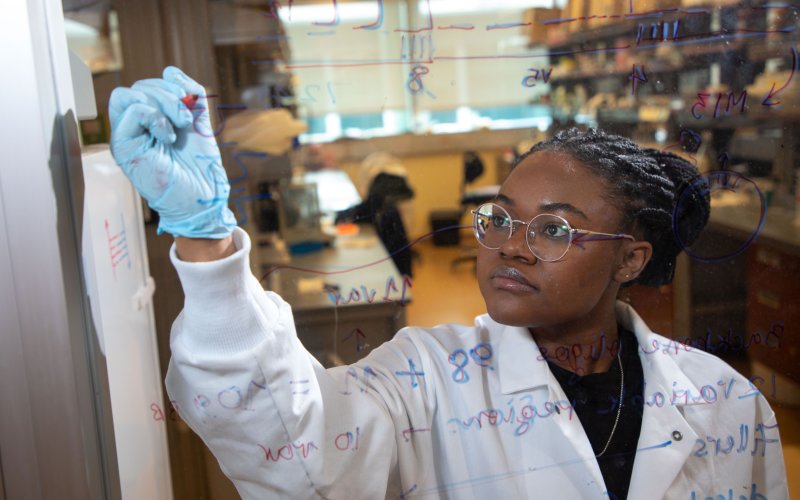Student Researchers Aided by CURCE Funding

ALBANY, N.Y. (April 12, 2022) — From using instant photography as a means to explore empathy, to researching how a specific gene affects reward-based behavior in the brain, to creating technology to improve emergency communications in rural areas, student researchers are contributing to advances in knowledge while gaining valuable, hands-on experience.
Nineteen student researchers got some support for their research through CURCE — the Center for Undergraduate Research and Creative Engagement — which provided awards ranging from $500-$750 in the Fall semester. The funds are designed to offset student expenses directly related to their research or creative projects with University faculty, including attending conferences, purchasing materials and covering tuition for related course work.
Award recipients will present their projects at CURCE’s 19th annual Student Conference, set for 3:30 to 6:30 p.m. on Friday, April 22, in the Lecture Center Concourse. A new round of student awards will be announced next week, which is Undergrad Research Week.
Current CURCE awardees include Ché-Doni Platt, a senior from Jamaica who is majoring in Biochemistry and Molecular Biology and plans to become a surgeon or OB/GYN. In the spring of 2021, she began working in the RNA Institute lab run by Senior Research Scientist Ken Halvorsen, which studies ways to detect and respond to RNA in search of improving disease diagnosis and treatment.
Platt’s research project is in long non-coding RNA detection using DNA nanoswitches. “My role in the project is to make reagents and execute experiments, as well as an analysis of results,” she said. “Joining the Halvorsen Lab has helped me to learn how to do experiments, nurtured my presentation skills and helped me to develop better study habits and life skills.”
Also working in the Halvorsen Lab is Kevin Thomas, a senior from Albany majoring in biology with a minor in bioethics.
His research project is in single-molecule biophysics, using “a relatively novel technique known as the centrifuge force microscope,” he explains.
“I always knew I wanted to be involved in research during college, but it was difficult to join labs during the COVID-19 pandemic,” Thomas said. “Luckily I had the chance to take an honors seminar course on single-molecule biophysics that was taught by my now research mentor. And after being interested in the topic, I got the opportunity to join the Halvorsen lab.”
Thomas has used his CURCE funding to offset the cost of attending a biophysics conference in San Francisco. His long-term goal is to become a doctor.
Of course, not all research is done in a lab. Jahniah Kum, an art major from Albany and Jamaica, is working on a project called “365 Days of Hello” that uses Polaroid photos to explore both empathy and how technology affects the formation of personal bonds.
“I got involved with this project due to my late mother who always reminded me that having people around you is important,” Kum said, adding she got her first Polaroid camera from her mother.
The project, she said, is a reminder of the significance of making memories. “Documentation is a staple for how we evolve, progress and preserve culture and who we are. This project is simply that.”
Kum, who expects to graduate in Spring 2023, would like to be a professor in painting and printmaking and ultimately return to the Caribbean.
Habib Affinnih, who is completing his masters this spring through a combined BS/MS program in computer science, is working on a project with associate professors Mariya Zheleva and Petko Bogdanov on ways to bring emergency communication capabilities to rural areas that lack reliable broadband.
“We are building an app that leverages WiFi-Direct, a technology readily available in consumer Android devices, and community interaction to disseminate emergency information within a community,” he said. “I am responsible for developing and maintaining new features for the app, maintaining the server and data ingestion pipeline, as well as analyzing the data collected from our deployments to guide the direction of future research.”
Affinnih’s goals are to continue working in computer science to “help solve problems and have a positive impact on people’s lives.”
Other CURCE-funded researchers include:
- Jaci Yong, a sophomore psychology major and neuroscience minor, is working in the lab of Associate Professor of Biology Annalisa Scimemi on how a particular neurotransmitter may affect rewards-based behavior. “This is my first formal experience in research, so I'm very grateful that I have gotten the chance to become familiar with a lab environment in my undergraduate years,” Yong said.
- Long Island senior Rachel Dolowich, a Human Development major with a concentration in counseling psychology, is doing research on how mindfulness and emotional intelligence can help patients with post-traumatic stress disorder heal.
- Sevinj Mursalova, a senior from Azerbaijan majoring in biology and minoring in neuroscience, is working in RNA Institute Director Andy Berglund’s lab, doing both data analysis and experimental work on the potential treatment differences for male and female patients with the neuromuscular disorder myotonic dystrophy.
- Emergency Preparedness, Homeland Security and Cybersecurity major Dierdre Occhino, a junior from Long Island, is researching state- and extremist-sponsored disinformation campaigns as part of her role at CART, the Center of Advanced Red Teaming. “My specific role was using open-source research and analysis to identify the general motives, intent, strategy and capabilities of adversaries to carry out attacks,” she said.
Funding for the CURCE awards was aided by gifts from several alumni — Kenneth W. Abele and Thelma Miller Abele, ’38; Lita Greenwald and Stephen Greenwald, ’40; Clyde Slocum, ’28 and Virgina Roosa Slocum, '32; Adelaid Schmid, ’38; and Adrienne Zimberg, ’83 — and University friend Robert W. Moyer,






